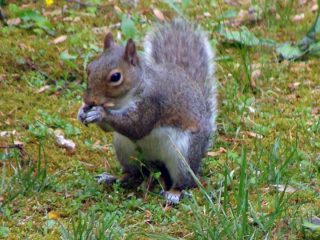
Baffling behavior in squirrels explained: Field Notes with Dennis Chastain

I have been puzzling for years over the question of why squirrels cut yellow tulip poplar flowers and drop them to the ground. It’s really a remarkable phenomenon, and one that has taken considerable research and observation to finally understand what is going on.
Every spring when the large, attractive flowers emerge, the area under the trees is covered.
Why are squirrels even interested in poplar flowers?

I have examined numerous poplar flowers on the ground and all their reproductive parts are intact and seemingly untouched. Also, I have never seen the squirrels show any interest in them once they fall to the ground. I did notice that they all had a length of the twig end of a branch attached. The twigs were of varying lengths, from a half inch to 5 or 6 inches long.
I recently found an old study done in the 1930s indicating that poplar flowers produce nectar, and quite a lot of it — so much so that honey bees could make more than two pounds of honey from one poplar tree.
Turns out the nectar is produced in droplets, like beads of sweat, on the orange-colored lower end of the petals, and eventually collects in pools at the base of the cup-shaped flowers. That probably explains why the squirrels are interested in poplar flowers. They’re after the sweet nectar, and that’s not unusual. Virtually all creatures, from ants to elephants, will work for a sugary treat. But it does not explain why they cut the flowers and drop them to the ground after sipping the nectar. When they cut the twigs where the flowers are, that flower will never produce nectar again. That just doesn’t make sense.
The revelation that unraveled the whole mystery came to me a couple of weeks ago when I happened to see a squirrel out on the end of a limb where I could observe exactly what it was doing.
Poplar branches are pretty weak. So, if the squirrel climbed out the limb to the point where the flowers are located, the limb would droop down and the flowers would tip over, spilling the nectar. Instead, what they do is go out a limb above the flower they are interested in and hang upside down to grasp the flower and pull it up to them.

Squirrels have curved claws and what are called “swivel ankles,” which means they can rotate their hind feet 180 degrees and hang like a bat on the roost. From that position, they can reach down and pull the flower toward them with the flower maintaining an upright position.
As I watched the squirrel go from flower to flower, I noticed that only two of five flowers fell to the ground. The others sprang back to their original position and will continue to make more nectar.
The twig end of a poplar branch is typically about as thick as a pretzel stick, and pretty brittle. Apparently, it is only by accident, when the squirrel bends the twig beyond its limits of flexibility, that the twig breaks and the flower falls to the ground.
Mystery solved.
Dennis Chastain is a Pickens County naturalist, historian and former tour guide. He has been writing feature articles for South Carolina Wildlife magazine and other outdoor publications since 1989.
The post Baffling behavior in squirrels explained: Field Notes with Dennis Chastain appeared first on GREENVILLE JOURNAL.

























